The cuisine of the Philippines, like so many areas of Philippine culture, is tightly coupled with the history, geography, and climate mixed together with about 120 different ethnic groups, each with their own local customs and history. It is an integral part of local art and culture.
Philippine cuisine has been strongly influenced by foreign foods brought in from traders and later immigrants. Some of the most notable are Malay, Chinese, Spanish, Mexican and American. The merging of the numerous indigenous foods with foreign influences resulted in what some refer to as the original fusion cuisine.
Most native Filipino dishes consists of rice with some kind of meat, such as fish, chicken or pork. Seafood figures prominently everywhere with grouper (lapu lapu), tuna, milkfish (bangus), squid, crab and prawn among the most popular. Through most of the country the food tends to be mild as hot spices common in other Asian countries are not used as much. Exceptions are the Bicol region and parts of Mindanao.
Note: we have found the book The Food of the Philippines – Authentic Recipes from the Pearl of the Orient to be one of the best (if not the best) introduction to Filipino cuisine. The articles in the first section are remarkable. What is Filipino food? by Doreen Fernandez wrote what in our opinion is the best introduction to the subject. Links to both the book (still in print) and article can be found in the links below.
A Few Popular Dishes
A few of the more popular dishes are described below. This list is just a small sampling and it should be noted that recipes and ingredients for any of these can (and often do) vary by location around the country. The References section below contains links to sites with more complete descriptions and recipes. And our references list is also just a small sampling as there are many excellent sites with Filipino food descriptions, recipes and pictures. So if you don’t find what you are looking for here (or just want to learn more), the popular search engines are your friend.
Fruits
The Philippines produces a huge number of fruits, many of which are unique to the region, some of which are among the most flavorful in the word. Many fruits are eaten by themselves, but others are used as ingredients for other staple dishes such as Sinigang (Tamarind). Others such as Mangos, Calamansi and Lychee are commonly used in drinks and desserts. The list below, while it may seen extensive is just a representative sampling of many wonderful fruits, flavors and textures awaiting you.
Most fruits are seasonal with the exception of bananas, coconuts, papayas and pomelos which are available year-round.
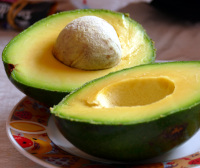
Avacado
May to September
Two types of avacados are found in the Philippines – the green-fruited and purple-fruited varieties. The later is usually the preferred choice. Eaten by itself, in salads, sandwiches, desserts, and even smoothies, the purple-fruited variety is rich in Vitamins A, C and E.

Banana
Year-round
Bananas can be found everywhere in the Philippines with the country being the second-largest exporter in the world. Popular varieties include lacatan, latundan, saba, cavendish and bungulan. They are eaten by themselves and also used in a variety of local dishes. They are high in potassium.

Bayabas (Guava)
September to December
Guava is a hard green fruit with a sweet, fragrant flavor when mature and bitter when unripe. They are often consumed as snacks by themselves and also used to make juice.

Buko (Coconut)
Year-round
The coconut, also referred to as the Tree of Life is a core part of Filipino culture and cuisine. They are everywhere around the country and can be seen in many of the festivals and in many local dishes including drinks and dessert. This healthy and nutritious fruit is not only used for food but also for cosmetics, medicine, ropes, mats, and even fuel.
Now that’s one versatile fruit! The Philippines is the second-largest producer of coconuts in the world.

Durian
August to October
Known as the King of Fruits, they have a very pungent aroma making them unwelcome guests in many venues. They have a very spiky exterior but the fruit is very nutrient-rich offering a blend of sweet and savory flavors, ranging from creamy to slightly bitter. Popular varities include Chanee, Monthong, Alcon Fancy, Arancillo and Puyat each in different shapes and colors from green, brown, yellow, and gold. They elicit strong feelings so most either love them or hate them!

Granada (Pomegranate)
August to December
Pomegranate is grown mainly for its seeds which have a sweet-tart flavor. They can be eaten directly or used in juice, smoothies, cocktails, jams, and other garnishes. They are a good source of antioxidants, fiber, vitamins A, B, and C, and minerals including calcium, potassium and iron. While the health benefits are well known, they are not yet widely cultivated commercially, making availability spotty at best.
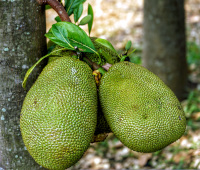
Langka (Jackfruit)
March to May
Jackfruit is a sweet fruit sometimes used as a meat substitute in vegetarian dishes. You can also find it in candies and desserts such as halo-halo and turon.

Mango
March to June
Mangos, the national fruit of the Philippines are also one of the most popular. Several varieties exist with the most notable being the sweet Carabao Mangos. Mangoes with their rich and creamy texture are widely used in local cuisine and are a common ingredient in desserts, salads and smoothies. They are rich in fiber, antioxidants and Vitamin C.
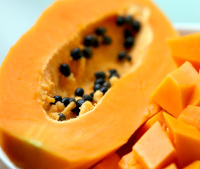
Papaya
Year-round
Referred to as the Fruit of the Angles due to its sweet and soft, butter-like consistency. Papaya is high in antioxidants such as Vitamins A, C and E.
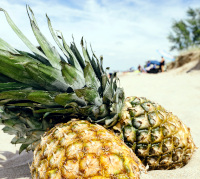
Pineapple
May to July
The Philippines is famous for its sweet and succulent pineapples, especially the Smooth Cayenne or Hawaiian variety. The Del Monte Plantation in Bukidnon is one of the world’s largest of its type. Pineapple is rich in Vitamin C.

Pomelo
Year-round
Pomelos, the largest fruit in the citrus family, are sweet-tangy fruits primarily grown in the Davao area. They are similar to grapefruit with a thick shell and thick, soft pith. The flesh color varies from a pale yellow to reddish-yellow. The taste is similar to grapefruit but sweeter with a bit of bitter. They are rich in fiber and antioxidants like Vitamin C.

Rambutan
August to October
This sweet fruit with hairy red skin hides a fruit similar to lychee. Best eaten when it is bright red in color (ripest and sweetest). It is delicious eaten by itself or as part of salads and desserts. They are high in potassium and an excellent source of Vitamin C and other antioxidants.
Drinks
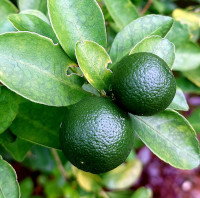
Calamansi Juice
Calamansi juice is made from the calamansi fruit, a small citrus fruit commonly called Golden or Philippine Lime. It is a hybrid of orange and kumquat and has a sour taste between lemons and limes. The fruit is rich in Vitamins A and C, potassium and calcium. This refreshing drink is made the same as one would make lemon or lime juice.

Fruit Shakes / Smoothies (Mango, Banana, Watermelon, Buko, Avacado, etc)
Fruit shakes, sometimes called fruit smoothies, are a blend of one or more fruits, milk (or alternative), a sweetener (optional) and ice cubes blended together. Variations sometimes include a type of ice cream in the mix. These are great afternoon snacks during hot days and any other time a cold delicious dessert is needed. Mango and Banana (or a combination of the two) are popular choices.

Buko Juice (Coconut Juice)
Coconut juice, also known as coconut water, is the liquid inside a fresh coconut. Fresh young coconuts are often harvested directly from the tree when they are still green. The top is chopped off and a hole bored in to get access to the liquid. It is also available canned or bottled.

Beer
Beer is the most consumed alcoholic beverage in the Philippines. 99.9% of the market is served by either San Miguel Corporation (94.7%/2021) and Asia Brewery (5.2%/2021). Some of the popular beers made by San Miguel Corporation include San Miguel Pale Pilsen, San Miguel Super Dry, Red Horse, and San Mig Light. The Philippines was ranked as the 22nd largest beer market in 2004 with a consumption growth rate of 15.6%.
Appetizer
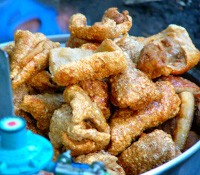
Chicharon
Pork chicharon (tsitsaron) is a popular finger food often accompanying beer. It is deep fried pork rinds served a spicy vinegar or bagoong sauce. Chicharon is easy to make at home but very time consuming. Available most anywhere including large supermarkets, sari-sari stores and street vendors.

Lumpiang Shanghai
Lumpiang Shanghai are Filipino spring rolls made with ground pork, chicken or beef filling combined with minced onions and vegetables such as carrots and then wrapped in thin crepes (lumpia wrappers). They are rolled into cylindrical shapes, deep-fried and then served with a sweet chili sauce.

Lumpiang Ubod (Heart of Palm Spring Rolls)
Lumpiang Ubod is a Filipino lumpia filled with palm heart of ubod, the edible pith from the coconut or palm tree. It is derived from Lumpiang Silay which originated in Silay, Negros Occidental. This dish uses various vegetables wrapped in a soft wrapper and garnished with sweet sauce and crushed peanuts.
Vegetables

Chop Suey (Mixed Vegetables)
Filipino Chop Suey is a popular stir-fried vegetable dish cooked with meats such as chicken, pork, shrimp and quail eggs. Vegetables can vary according to taste but often include cabbage, celery, bean sprouts and carrots. It is an easy to prepare and healthy dish.
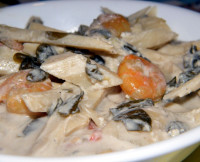
Ginataang Labong (Bamboo Shoots with Coconut)
This is a simple to cook vegetable stew made with bamboo shoots and coconut cream mixed with spices and seafood or meat.
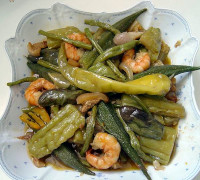
Pinakbet (Vegetable Medley w/Shrimp Paste)
Pinakbet is a classic Filipino vegetable stir-fry dish that originates in the Ilocos region of Northern Luzon. It is popular across the country. Pork or fish are used in most versions together with a fermented fish sauce, bagoong isda (Pinakbet Ilocano) or a fermented shrimp or krill paste,bagoong alamang (Pinakbet Tagalog).
Beef

Bistek Tagalog (Pinoy Beefsteak)
Bistek Tagalog is a popular and easy to prepare Filipino Beefsteak recipe. It is made of thinly sliced sirloin braised in a mixture of citrus (usually calamansi), soy sauce, onions and garlic and served with white rice. It is common in the Tagalog and Western Visayan regions.
Chicken
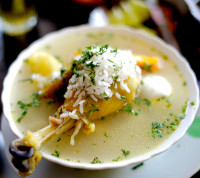
Arroz Caldo con Pollo (Chicken Soup with Rice)
Arroz Caldo is a Filipino chicken porridge (congee) made by cooking rice in chicken stock until it’s thick and creamy. Best when topped with hard boiled eggs, chopped scallions, toasted or roasted garlic and calamansi or lime.
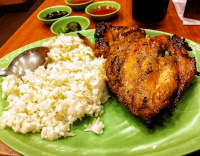
Bacolod Chicken / Inasal Manok (Grilled Native Chicken)
Inasal Manok, sometimes called Bacolod Chicken, is a very popular dish that originated in Bacolod City, Negros Occidental. You can find this almost anywhere in the country these days. It is a grilled chicken marinated in a unique blend of vinegar, calamansi juice, annatto seeds, garlic and lemongrass and served with white rice. The annatto seeds in the marinade give the chicken its distinctive bright, reddish-orange color.

Fried Chicken
Filipino fried chicken is very similar to American fried chicken with the exception that American style is usually deep-fried while in the Philippines it is shallow, or pan fried. A well loved comfort food that all ages can enjoy.
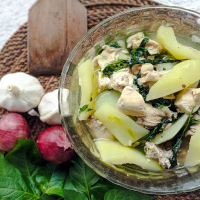
Tinolang Manok (Chicken Soup)
Chicken Tinola is a classic Filipino food and one that is loved across the country. It is made with fresh chicken boiled with slices of green papaya or sayote, ginger, chopped onions, garlic, fish sauce and chili or malunggay leaves. Malunggay is a local plant that is considered a superfood because of its high nutritional content, vitamins and minerals and is used as a garnish in many Filipino soups.
Noodles

Pancit (Canton, Batchoy, Malabon, Molo, Buko)
Pancit refers to various noodle dishes. The types of pancit are named based on the noodles used, method of cooking, and place of origin. Most dishes are served with calamansi. Other ingredients vary by the type of dish but include meat, fish, and various vegetables and spices. Common types include Canton (egg noodles), Bihon (rice vermiceli), Batchoy (Iloilo stir-fry), Malabon (thick noodles from Malabon), Molo (wonton wrappers instead of noodles), and Buko (coconut strips instead of noodles).
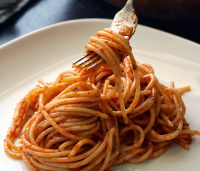
Spaghetti
Filipino spaghetti is also known as sweet spaghetti. Similar to Italian spaghetti bolongnese but it has a very sweet sauce. This sauce is made from tomato sauce sweetened with brown sugar and banana ketchup. Often topped with sliced hot dogs or longganisa sausages, ground meat and grated cheese.
Pork

Crispy Pata (Deep Fried Pork Legs/Knuckles)
Often served on special occasions, Crispy Pata is a whole pork leg boiled until tender, then dried and deep-fried until golden brown and crispy. It is often served with a soy sauce-vinegar dip and white rice. The dish is very similar to the German Schweinshaxe.
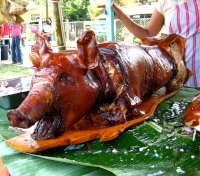
Lechon / Roasted Pig
Lechon Baboy is a traditional Filipino dish especially popular during feasts and celebrations. It is known for its crispy skin and tender meat. The whole pig is slowly spit-roasted over an open fire which is quite time intensive. The pigs are stuffed before roasting. Stuffing ingredients vary by region. Examples include Cebu Lechon (unique marinade of spices and herbs), Negros Lechon (sweet, tangy flavor due to the use of cane vinegar and calamansi) and Batangas Lechon (stronger garlic taste).
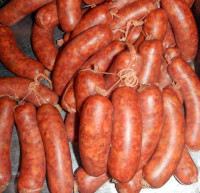
Longganisa
Longganisa are Filipino sausages flavored with spices. They are usually dyed red, yellow, or orange with achuete seeds. There are many variants from different regions in the country. Some examples include Alaminos longganisa (pork from Pangasinan), Calampit longgansia (Bulacan), Chorizo Negrense (Bacolod pork), Pampanga longganisa (pork), Tuguegarao longganisa (pork, Cagayan Valley).
Seafood
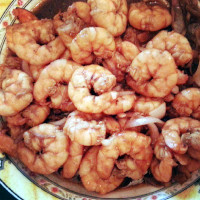
Adobong Hippon sa Gata (Prawn Adobo in Coconut Milk)
Shrimp Adobo in Coconut Milk is a simple and quick meal to make. It is made with large shrimp or prawns, coconut milk and adobo sauce and usually served with rice.
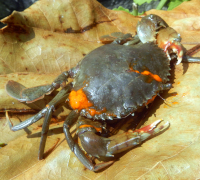
Rellenong Alimango (Stuffed Crab)
Relleno is a cooking method of stuffing different meats and vegetables into food items like chicken, squid, crab or fish. This dish combines crab meat, vegetables and perhaps other stuffing ingredients such as potatoes to create the stuffing. It is then fried, put back in the crab shell and briefly deep fried. Usually served with a simple dip or just banana or tomato ketchup.

Sinigang na Bangus (Milkfish Soup)
Sinigang is sour soup or stew normally associated with the tamarind fruit. It is a widely used cooking method across many Filipino dishes. Bangus, or Milkfish is the national fish, making this one of the more popular dishes in the country.
Desserts

Buko Pie
Buko pie is a Filipino-style coconut pie made with fresh coconut meat combined with a creamy filling and enclosed in a flaky pie crust. Inspired by American apple pie, this recipe originates from Laguna and is especially popular in Southern Luzon.

Buko Salad
Buko salad is a very popular dessert combining shredded coconut (buko) fillings, fruits, and nata de coco (fruit of sugar palms) into a thick coconut cream and condensed milk base. Buko salad is a classic dish served at most celebrations and fiestas.

Halo-Halo (exotic fruit mix)
Known as the Queen of Desserts, this is the country’s most popular dessert. It is a mixture of shaved ice, milk and various boiled sweet beans and fruits. Ube ice cream is common. The ingredients can vary however all are sweet. Served cold in a tall glass or bowl.

Leche Flan
Leche flan is a classic Filipino caramel custard dessert made up of milk, sugar, eggs and vanilla flavoring. It is often oval shaped but is common to see it prepared in large rectangular pans or other baking molds.

Mango Sago
Mango Sago is a delicious and simple to make summer dessert that combines fresh, sweet mangoes with chewy sago pearls (tapioca), coconut milk and a bit of condensed milk. The dish comes from Hong Kong but is also popular across the Philippines.
References
- 25 Most Popular Filipino Foods – Chef’s Pencil
- 30 Authentic Filipino Recipes – Insanely Good Recipes
- 35 Delicious Filipino Recipes You’ll Want to Make on Repeat – Jan Valdez / the kitchen
- 40 Traditional Filipino Dishes to Try in the Philippines – Laura Lynch / Savored Journeys
- Adobo to turon: 50 dishes that define the Philipppines – Maida Pineda and Candice Lopez-Quimpo / CNN
- Adobong Hippon (Shrimp Adobo) – Debbie Tingzon / Flickr
- Alimango with aligue textures 06.jpg – Wikimedia Commons
- Arroz Caldo con Pollo.jpg – pixabay
- Bistek Tagalog-02.jpg – Wikimedia Commons
- Buko Salad.jpg – PinoyFoodTaste
- Chicharon.jpg – MicahPiosDad / flickr
- Chicken inasal.jpg – Wikimedia Commons
- Chicken tinola.jpg – Wikipedia Commons
- chopsuey.jpg – Needpix.com
- Filipino cuisine – Wikipedia
- Filipino cuisine – Wiki Voyage
- Filipino Food – 15 Traditional Dishes to Eat in the Philippines – Destinavo
- Filipino Food: 45 Traditional Dishes to Look For in the Philippines – Will Fly For Food
- Filipino Food 101: Recipes to Get You Started – Kristina Razon / serious eats
- Filipino Fruits: 30 of the Most Delicious Fruits in the Philippines – Will Fly For Food
- Filipino Leche Flan recipe (50277747301).jpg – Wikimedia Commons
- Foods of Bulacan Philippines (Longganisa).jpg – Wikimedia Commons
- Fried Lumpia.jpg – pulaw / flickr
- Ginataang Labong (Bamboo shoots in coconut milk) – adobongblog
- Halo-Halo Filipino Dessert – Joost Nusselder / Flickr
- List of Philippine dishes – Wikipedia
- Lumpiang Ubod.jpg – Wikimedia Commons
- Mango Milkshake.jpg – Wikimedia Commons
- Mango Sago – The Woks of Life
- Marison’s Sotangon Guisado.jpg – badudetsmedia / flickr
- Pancit.JPG – whologwhy / flickr
- PH Beer.JPG – Chris Matthews / Pexels
- Pinakbet3.jpg – Wikimedia Commons
- Philippines Cuisine: 20 Must-Try Traditionall Filipino Dishes – Travel Food Atlas
- Pomelo fruit.jpg – Wikimedia Commons
- Sinigang na Bangus sa Biyabas 02.jpg – Wikimedia Commons
- The Best Dishes Food Guide in The Philippines – culture trip
- The Food of the Philippines: Authentic Recipes from the Pearl of the Orient – Reynaldo Alejandro, Doreen G. Fernandez, Corazon S. Alvina, Millie Reyes – 120 pages / Amazon
- Tikim: The remarkable legacy of Doreen G. Fernandez – R. C. Ladrido, VERA Files
- Top 76 Filipino Foods – tasteatlas
- Traditional Filipino Food – 18 Best Filipino Dishes To Try in the Philippines – Raymond Cua / Travelling Foodie
- tselogs buko pie – Krista / Flickr
- What Is Filipino Cuisine? – Angelo Comsti / Food Philippines
- What is Filipino Cuisine? – Food Philippines – YouTube
- What is Filipino food? – Doreen Fernandez
- What Is Filipino Food? – Doreen Fernandez and Edilberto Alegre – Tagalog Lang
About The Author
Hi, I'm Tim and the main architect of this site. We're trying to get comprehensive content up as quickly as possible and despite our best efforts do expect for some errors to get through. If you notice any mistakes or things that you think can be better explained please do let us know. If you're interested in contributing content (properly attributed of course) let me know - we're very interested in working with contributors. More info at https://tim.kehres.com


